
Eat your fuchsias! Recipes and more.
Yes, fuchsia berries are edible. The flowers, too!
Yes, fuchsia berries are edible. The flowers, too!

Rest assured,though. All parts of the fuchsia are non-toxic and all parts are completely edible, from the berries to the flowers. Or the leaves, for that matter, if you’re into that kind of fodder. This fact is often a complete surprise to most gardeners and growers, even ones that have had fuchsias on the porch or in their beds for decades.
It should put the minds of parents and grandparents at ease, when they discover that Junior hasn’t just been impishly popping the flower buds, but merrily popping the berries into his mouth with reckless abandon. And dog owners can relax. Fido has been known to nip a few low-hanging fruit from the fuchsia bush a time or two. They’re also non-toxic to canine connoisseurs.
Fuchsias are perfectly safe to eat. Plus, they’re tasty!
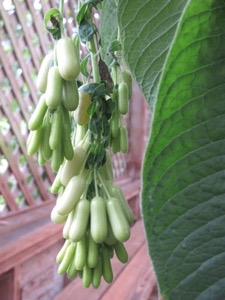
At the top of any list should be Fuchsia boliviana, which is regularly eaten by native peoples in the Andes. In fact, the native range of the species is a little hazy because its berries, at the very least, were early on carried away from their homelands in northern Argentina, Bolivia and southern Peru and into the northern Andes in Columbia and Venezuela. Probably Central American as well.
F. boliviana is still encountered along old Inca trails and roads, or around habitations, and still sometimes sold in traditional markets in Bolivia, Ecuador and Peru. Native names for this species in the Quechua language of the Inca include quwapaq ñukch'u, chimpu-chimpu and uchu-uchu. In Andean Spanish, they’re referred to as corazón corazón (heart-heart) and are believed to be good for what ails both the heart and spirit.
On the other side of the Pacific, Fuchsia excorticata berries are traditionally eaten by the Maori of New Zealand who call their huge native tree fuchsia, kotukutuku, and the berries themselves, konini. There is an old Maori saying, "I whea koe I te tahuritanga o te rau o te kotukutuku?", or, "Where were you when the leaves of the fuchsia tree began to grow in the spring?”. Kotukutuku is one of Aotearoa’s few deciduous trees and drops it’s leaves in the southern fall. This saying is a reproach to those who show up at harvest time to reap the bounty but were nowhere to be found when real garden work needed to be done at planting time in the spring.
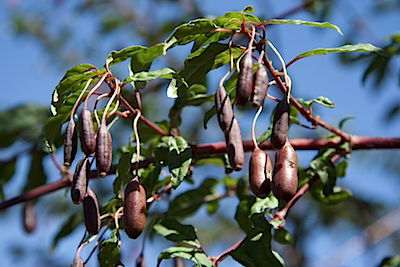
Like the roses of England or the thistles of Scotland, F. magellanica seems to have become somewhat of the floral emblem of this beautiful winter-and-summer resort on Nahuel Huapi Lake, a large glacial lake surrounded by the snow-crested Andes. The town’s also come to be known for its Swiss Alps-ish architecture. And its chocolate sold in shops lining its main street, the Calle Mitre. Function follows form, I suppose. Still, F. magellanica abounds.
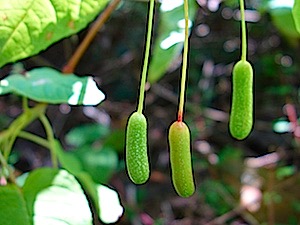
The taste of fuchsia berries can be variously described as lemony or peppery and has a pleasing sub-acid quality. The fruit on garden cultivars, however, ranges considerably in its degree of delectability. Some are absolutely splendid; other are simply bland. It’s important to remember that most all hybrids were bred for the looks of their ornamental flowers rather than for the taste of the berries. Also, the berries should be fully ripe or they’re a bit starchy.
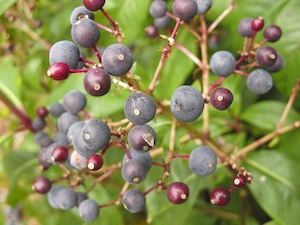
If the berries of one kind of fuchsia don’t measure up, move on to the next. Fuchsia berries are said to be high in Vitamin C and antioxidants. They’re enjoyed fresh or used in recipes such as jellies, jams and puddings.
A common problem with cooking with fuchsia berries is simply collecting enough of them from the typical garden to be useful. Unless you have a hedgerow, or somehow providentially manage a large fuchsia plantation, the crop can be slow to add up. Not to fear, you can easily freeze the berries until you’ve collected enough for a pie. That’s if they make it past your mouth in the first place.
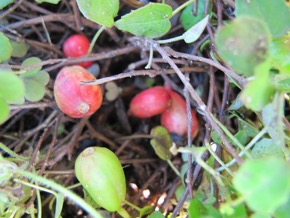

Fuchsia flowers are edible, as well, and can used as a colorful floral garnish in salads and elsewhere. Scientific studies have shown that the flowers are high in anthocyanins, the group of compounds that give these flowers their distinctive fuchsia red and blue and purple coloration. Anthocyanins are strong antioxidants. Further studies need to be undertaken to determine the precise health benefits eating fuchsia flowers might have. (See ➤ Scientific Bibliography)
Here are a some common recipes for you to try. The measurements are English but I’ve noted the approximate equivalents if you’re metric. In the meantime, fresh or cooked, salad or pudding, enjoy!
(Illustrations: 1. Fuchsia berries ripening on the bush; 2. The berries of F. boliviana var. alba are pale green when ripe; 3 & 7. F. magellanica; 4. F. splendens; 5. Berries in various stages of ripeness on F. paniculata; 6. F. procumbens.)
Fuchsia Berry Jelly
1 cup fuchsia flowers [ ≈ 250 ml]
1 cup ripe, washed fuchsia berries
1 cup sugar
Juice of 1 lemon
2 cups of water (or apple juice or apple cider)
1 apple, sweet, peeled and chopped
2 tablespoons of unflavored gelatin [ ≈ 30 ml; 1 tbs ≈ 15 ml]
Simmer the flowers, berries, sugar, lemon juice, water, and apple for 10 minutes.
Let the mixture cool a bit, then strain it.
Add the gelatin and allow it to thicken in the refrigerator.
1 cup fuchsia flowers [ ≈ 250 ml]
1 cup ripe, washed fuchsia berries
1 cup sugar
Juice of 1 lemon
2 cups of water (or apple juice or apple cider)
1 apple, sweet, peeled and chopped
2 tablespoons of unflavored gelatin [ ≈ 30 ml; 1 tbs ≈ 15 ml]
Simmer the flowers, berries, sugar, lemon juice, water, and apple for 10 minutes.
Let the mixture cool a bit, then strain it.
Add the gelatin and allow it to thicken in the refrigerator.
Fuchsia Berry Jam
1 lb. sugar [ ≈ 450 g]
2 tablespoons water (or apple pectin, apple juice or cider) [ ≈ 30 ml; 1 tbs ≈ 15 ml]
juice of 1 lemon
1 ½ lb. of ripe fuchsia berries, washed [ ≈ 525 g]
Combine the sugar, water and lemon juice in a pan and cook carefully over low heat until the sugar dissolves.
Set the mix aside and allow it to cool completely.
Add the berries gently, folding them into the mixture so as not to break them up too much.
Bring the mixture slowly to a boil.
Boil until the mixture will set when it’s tested on a plate.
Seal in heated jars.
Allow to cool completely before eating.
1 lb. sugar [ ≈ 450 g]
2 tablespoons water (or apple pectin, apple juice or cider) [ ≈ 30 ml; 1 tbs ≈ 15 ml]
juice of 1 lemon
1 ½ lb. of ripe fuchsia berries, washed [ ≈ 525 g]
Combine the sugar, water and lemon juice in a pan and cook carefully over low heat until the sugar dissolves.
Set the mix aside and allow it to cool completely.
Add the berries gently, folding them into the mixture so as not to break them up too much.
Bring the mixture slowly to a boil.
Boil until the mixture will set when it’s tested on a plate.
Seal in heated jars.
Allow to cool completely before eating.
Fuchsia Berry Scones
Here's a basic fuchsia scone recipe. Or just add the fuchsia berries to your own favorite recipe as you might blueberries.
4 cups flour [ ≈ 950 ml]
6 tablespoons sugar [ ≈ 90 ml; 1 tbs ≈ 15 ml]
½ teaspoon salt [ ≈ 5 ml]
4 ½ teaspoons baking powder [ ≈ 21 ml]
½ cup cold butter, plus 2 another tablespoons of cold butter [ ≈ 120 ml + 30 ml]
2 large eggs at room temperature
¾ cup whole milk, plus another 2 tablespoons of milk [ ≈ 175 ml + 30 ml]
1 ½ cups of ripe fresh or frozen fuchsia berries [ ≈ 350 ml]
Combine the flour, sugar, baking powder and salt in a bowl.
Slowly cut in the ½ cup of butter until the mixture resembles coarse crumbs.
Whisk the eggs and ¾ cup milk together in a bowl.
Add the egg and milk mixture to the dry ingredients until just moistened.
Place the mixture onto a lightly floured surface.
Very gently knead in the fuchsia berries.
Divide the dough in half.
Gently pat down each portion into an 8 in. circle
Cut each circle into 8 wedges.
Place the dough onto greased baking sheets.
Brush with the remaining 2 tablespoons of milk.
Bake at 375° for 15-20 minutes, or until the scone tops are golden brown.
Here's a basic fuchsia scone recipe. Or just add the fuchsia berries to your own favorite recipe as you might blueberries.
4 cups flour [ ≈ 950 ml]
6 tablespoons sugar [ ≈ 90 ml; 1 tbs ≈ 15 ml]
½ teaspoon salt [ ≈ 5 ml]
4 ½ teaspoons baking powder [ ≈ 21 ml]
½ cup cold butter, plus 2 another tablespoons of cold butter [ ≈ 120 ml + 30 ml]
2 large eggs at room temperature
¾ cup whole milk, plus another 2 tablespoons of milk [ ≈ 175 ml + 30 ml]
1 ½ cups of ripe fresh or frozen fuchsia berries [ ≈ 350 ml]
Combine the flour, sugar, baking powder and salt in a bowl.
Slowly cut in the ½ cup of butter until the mixture resembles coarse crumbs.
Whisk the eggs and ¾ cup milk together in a bowl.
Add the egg and milk mixture to the dry ingredients until just moistened.
Place the mixture onto a lightly floured surface.
Very gently knead in the fuchsia berries.
Divide the dough in half.
Gently pat down each portion into an 8 in. circle
Cut each circle into 8 wedges.
Place the dough onto greased baking sheets.
Brush with the remaining 2 tablespoons of milk.
Bake at 375° for 15-20 minutes, or until the scone tops are golden brown.